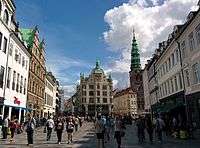Amagertorv

Amagertorv (English: Amager Square), today part of the Strøget pedestrian zone, is often described as the most central square in central Copenhagen, Denmark.[1] Second only to Gammeltorv, it is also one of the oldest, taking its name from the Amager farmers who in the Middle Ages came into town to sell their produce at the site.
Now the square is a central junction in the heart of Copenhagen, dominated by its Stork Fountain and a number of buildings, the oldest of which dates back to 1616. In opposite directions, Strøget extends towards Kongens Nytorv and the City Hall Square, the two largest squares in Copenhagen, to the northwest Købmagergade leads to Nørreport, the busiest railway station in Denmark, and to the southeast Højbro Plads connects to Slotsholmen across Højbro Bridge, and from there onwards to Christianshavn and Amager on the other side of the harbour.
The paving is from 1993 and was designed by Bjørn Nørgaard. It consists of a pattern of pentagonal granite stones in five colours.[1]
History

Amagertorv dates back to the Middle Ages when Copenhagen was a small fishing village called Havn, the site was the main corridor between the village and the beach. In 1449 it is referred to as the Fishmonger's Market and in 1472 the name Amagertorv first appears. The name derives from the Amager farmers who came into town to sell their goods.[2]

In the 16th and 17th century the square became a setting of festivals and chivalrous tournaments. In the same time, Amagertorv continued to be the premier marketplace of the city and from 28 July 1684 all sale of fresh produce was to take place in the square.[2] From 1656 the city's leading inn was also located on the square. The adjoining Højbro Plads was established after the Great Fire of 1795. In 1868 the market activities were moved to Christianshavn.
In 1894, the Stork Fountain was constructed. It was a present to Crown Prince Frederik (later Frederik VIII) and Crown Princess Louise in connection with their silver wedding. In 1962, the square was closed to traffic with the establishment of the Strøget pedestrian zone.[3]
Buildings


- Mathias Hansen House at No. 6 was built in 1616 for Mathias Hansen, from 1622 the Mayor of Copenhagen. Typically of the Dutch Renaissance style, the house is built in red bricks with sandstone decorations, has a Dutch gable and a copper roof. The copper drainpipes are decorated with dragon's heads.The building was restored in 1898 by Professor Hans Jørgen Holm. The gateway is flanked by two cannon barrels used to protect the gate from entering carts.[4]
- No. 9 was built 1798-1800: for linen merchant J. A. Bechmann. The original shop front at street level was changed in 1830 and again in 1870. The tobacco company W. Ø. Larsen has a small pibe museum in the building.[5]
- No. 14, Ole Haslund's House, is an example of 19th century Historicism. The current design is from 1867. The windows have mullions executed as small Hermes figures carrying Ionic capitals.[6]
- Klostergården at No. 29 is a former convent. The building is from 1798-00 where it replaced a house designed by Caspar Frederik Harsdorff which was destroyed in the Great Fire of 1795. The convent was founded in 1759.[7]
Shopping

The Illum department store has been located on the corner of Strøget and Købmagergade since the 1890s. The Illum Furniture Store is also located at Amagertorv. Royal Copenhagen has a flagship in the historic building at No. 6.
See also
References
- 1 2 "Amagertorv". Danish Architecture Centre. Retrieved 2010-01-11.
- 1 2 "Amagertorv". Selskabet for Københavns Historie. Retrieved 2010-01-11.
- ↑ Gehl, Jan; Gemzøe, Lars (1996). Public Spaces, Public Life, Copenhagen. The Danish Architectural Press and the Royal Danish Academy of Fine Arts. p. 17. ISBN 877 407 305 2.
- ↑ "Amagertorv 6". Selskabet for Københavns Historie. Retrieved 2010-01-011. Check date values in:
|access-date=(help) - ↑ "Amagertorv 9". Selskabet for Københavns Historie. Retrieved 2010-01-011. Check date values in:
|access-date=(help) - ↑ "Amagertorv 14". Selskabet for Københavns Historie. Retrieved 2010-01-011. Check date values in:
|access-date=(help) - ↑ "Amagertorv 29". Selskabet for Københavns Historie. Retrieved 2010-01-011. Check date values in:
|access-date=(help)
External links
| Wikimedia Commons has media related to Amagertorv. |
Coordinates: 55°40′43″N 12°34′39″E / 55.6786°N 12.5774°E